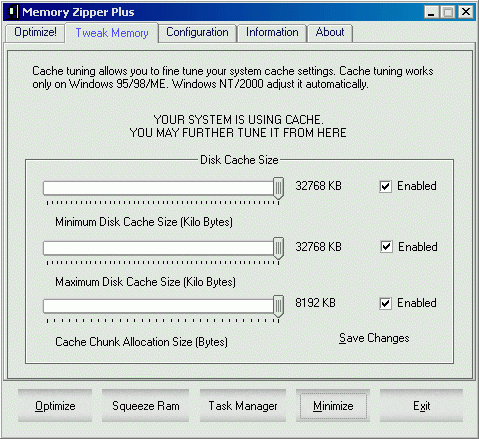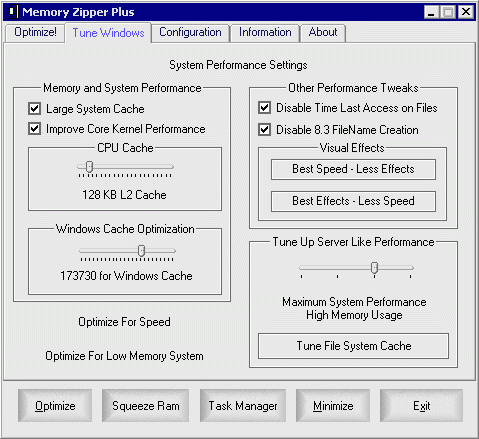
Memory Zipper Plus
RAM Performance Optimizer and Resource Monitor
Help File and Instructions
How to use Memory Zipper Plus - Tune Windows.
Memory Zipper Plus behaves diffrently when run in Windows 95/98/ME and int Windows NT/2000/XP. It shows diffrent options to tune Windows.
Windows 95/98/ME - Tweak Memory.
Windows NT/2000/XP - Tune Windows.
Tweak Memory TAB - Windows 95/98/ME

Here you can adjust the VCache settings. VCache is very important for windows 95/98 and ME. Windows NT/2000 manages the cache automatically. If the cache settings are not specified then windows will end up using the entire memory for cache and start using the virtual memory. It will not only degrade the performance but will also result in crashes.
For most efficiency both minimum and maximum cache should be of same size. The should be in the range of 1/8 to 1/6 of physicl memory. VCache should not exceed 32 MB as more cache will also degrade the performance.
Chunk size is the Block size in which windows manages the cache. If larger block size s specified more data will be stored in the blocks but there will be fewer blocks. If too much small size is specified there will be larger blocks with data scattered all over. So for most efficiency Chunk size should be in the range of 512 to 4096 bytes.
Tune Windows TAB - Windows NT/2000/XP

On Windows NT/2000/XP Memory Zipper shows different settings. Lets summarize them.
Memory and System Performance
| CPU | Cache |
| P-II 233 MHz to 450MHz | 512 KB |
| P-III upto 550 MHz | 512 KB |
| Celerons - 300 MHz and Above | 128 KB |
| P-III above 650 MHz | 256 KB |
For Xeon and AMD based CPU consult your manual.
Optimize for Speed and Optimize for Minimum Memory - This will tweak system respectively. But for system with 128 MB RAM or more use optimize for speed.
File System Tweaks
1. Disable Time Last access - On NTFS systems while browsing for directories or searching for files can be painful. As windows will coninously be updating Time Stamps. It will slow down a system with each read or write. Recommeded ON.
2. Disable 8.3 File Names - It will disable creating 8.3 old short file names on NTFS volumes. It could improve performance. If you do not use old DOS applications then enable this tweak. If you use old dos apllications and when you enable this tweak any new filename you have created will not be accessible in that DOS. Recommended ON.
Visual Effects - They could slow down system. Even a speedier Processor could feel like doing nothing. They also waste time while drawing such effects. Recommended Disable Visual Effects.
<<Home Optimize Tab Memory Zipper Plus Configuration>>
(c) systweak 2000-2001